MacArthur Elementary School Featured in Issue of Landscape Architect and Specifier Magazine
06.05.2008
Through the creative efforts of STUDIO39 Senior Landscape Architect, David Judd, ASLA, the Douglas MacArthur Elementary School playground, schoolyard and outdoor classroom was featured in the June 2008 Schools issue of Landscape Architect and Specifier News. The project, which features a circular outdoor classroom, landscape and playground improvements was completed in June 2007. The outdoor classroom design includes a circular concrete sitting area with large seating boulders. The article can be found at http://www.landscapeonline.com by doing a keyword search for “MacArthur Elementary”.
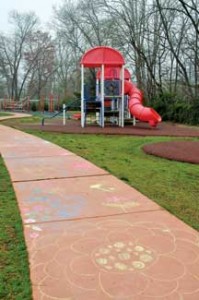
The red concrete walking trail acts as a flexible element in the landscape. The students use it for walking, running, drawing and other forms of play.
It initially started as a small idea, involving the improvement of drainage around the school’s kindergarten classroom, otherwise known as the ‘kindergarten pod’, and the returfing of mud-entrenched playing fields. Three years and numerous PTA meetings and fundraisers later it evolved into a comprehensive makeover of the school’s outdoor play area, involving the construction of an outdoor walking trail, pathways between play elements and the creation of an outdoor classroom dedicated to the school’s committed principal Deborah Thompson as a thank you for her 30-plus years of service.
Macarthur Elementary School in Alexandria, Virginia is located just outside our Nation’s Capitol. It serves 583 students and is one of thirteen public elementary schools in the Alexandria area. In the summer of 2004 ideas began to circulate at the school’s monthly Parent Teacher Association meeting about the need for improvements to the existing outdoor play areas. Years of wear and tear had turned the playing fields into literal mud baths and the poor drainage around the building was threatening to seep into the classroom space. The playground areas were unsightly and the mulch below the playground equipment had a tendency to make its way back into the classrooms along with the mud. At the time, David Judd of Alexandria’s STUDIO39 Landscape Architecture, P.C. had just started sending his daughter, Samantha, to the school.
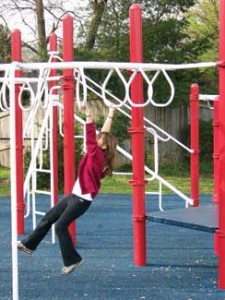 New playground equipment provides a place for older kids to climb. The blue soft surfacing underneath the equipment provides a cushion to any falls.
New playground equipment provides a place for older kids to climb. The blue soft surfacing underneath the equipment provides a cushion to any falls.
Along with the other members of the PTA, Judd felt that vast improvements could be made to the outdoor spaces off of the school’s library, kindergarten classrooms and cafeteria.
In the fall of 2004 Judd and the members of the PTA began a brainstorming process to prioritize the need for improvements to the existing landscape. This wish list was both the impetus and the inspiration behind the final design of a 750-foot curvilinear colored concrete walking trail, concrete pathways, outdoor kindergarten space, new basketball court, playground area and outdoor classroom.
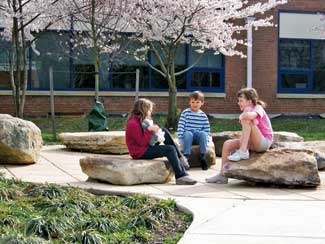 The fieldstone boulders in the outdoor classroom provide a place for students to sit and talk. Edge plantings around the outdoor classroom include liriope muscari and evergreen shrubs.
The fieldstone boulders in the outdoor classroom provide a place for students to sit and talk. Edge plantings around the outdoor classroom include liriope muscari and evergreen shrubs.
The process took three years to complete. The collaborative approach between the designers, PTA and city made this a flagship example for other schools in the city. By raising money through fundraisers, as well as taking advantage of Alexandria’s School Facilities Department’s pre-existing goals and budget, the project maximized the potential changes that could be made to the landscape. The final design is both visually pleasing and low maintenance, a must-have for a public institution.
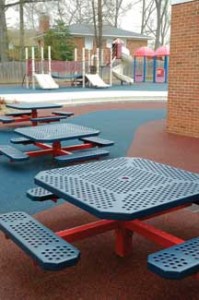 Recycled rubber soft surfacing and metal tables were installed outside the kindergarten pod. New drainage around the area prevents the buildup of water.
Recycled rubber soft surfacing and metal tables were installed outside the kindergarten pod. New drainage around the area prevents the buildup of water.
The site of the redesign is located to the side of the one story L-shaped school building, sheltered by woods to the north and west and the building to the south and east. The main entrance to the site is from double doors off of the school’s main hallway. The doors lead out onto a concrete walkway facing west. A circular concrete pad is set into the path just outside the door, currently edged by small beds intended as “learning gardens.”
Currently the beds contain spring herbs of parsley, sage and rosemary with small plaques discussing each. Past the circle, the path splits into three separate pathways. The left path leads to the outdoor classroom while the paths leading straight and right curve around the building, connecting further classrooms to the space and leading to separate ends of the curvilinear walking trail.
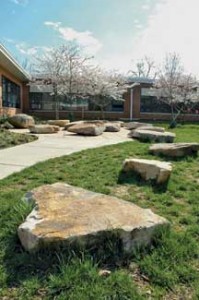 Individual boulders line the path to the outdoor classroom area. Boulders were hand picked at a local quarry.
Individual boulders line the path to the outdoor classroom area. Boulders were hand picked at a local quarry.
A red Japanese maple heralds the entry to the outdoor classroom area, where a curved walk branches left off the main walk, leading to a pleasant concrete paved circular area containing a series of fieldstone boulders. Eleven low, flat boulders are arranged in a radial pattern around the circle while a larger boulder is provided at the head of the circle for the teacher. Judd and the head of the PTA, Jim McClary, went to the quarry themselves to pick the boulders by hand resulting in each boulder being perfectly suited to fit three small people. Evergreen plantings around the circle, which sits just outside the school’s library window, soften the edges of the space, while helping to emphasize the rustic nature of the classroom. A variety of trees were planted outside the perimeter of the circle intended to eventually serve as a maintenance free “shade structure” for the learning area. The trees are notable for their varied color and leaf-structure and include Ginko Biloba, Acer Rubrum ‘Red Sunset’ and Ulmus Parvifolia.
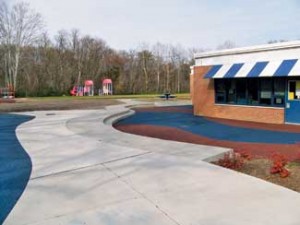 Curving concrete stairs separate the playground from the kindergarten pod play area. The stairs provide a good place for younger children to sit, play and climb.
Curving concrete stairs separate the playground from the kindergarten pod play area. The stairs provide a good place for younger children to sit, play and climb.
From the outdoor classroom you can see the walking trail, which weaves its way through the outdoor landscape, but attention is focused inwards towards the building where the teacher’s boulder sits as opposed to outwards towards the playground areas.
The concrete walking path meanders through the outdoor landscape. It is used both as a connection between the landscape elements and a running track, which both the students, and neighborhood residents use. According to McClary and Principal Thompson, the track was one of the top priorities on the team’s wish list. Prior to the construction of the track the students ran the requisite mile over muddy uneven grass and dirt. The installation of the track provided both a connection between elements and a much-needed place for physical activity. Thompson thinks that the creation of the track has also encouraged walking among the students. The curves and swoops of the trail make it an interesting place to stroll and students can often be seen walking down it while talking with their friends. The track weaves along the perimeter of the site, arching out to connect to a newly installed basketball court, and three areas of playground equipment. The curving path is both visually attractive and stimulating to walk on.
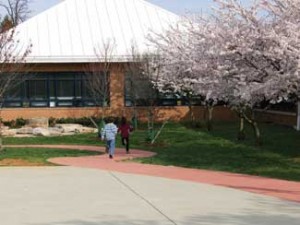 The non-uniform shape of the walking trail makes for an interesting transition between site elements.
The non-uniform shape of the walking trail makes for an interesting transition between site elements.
At the center of the track is the playing field, now regraded to be flat with slightly sloping edges to encourage drainage from the space. During the design phase the team discussed installing soccer goals or other equipment on the field, but opted to leave the space open to encourage the largest variety of play opportunities possible. Open programming such as this has made the site adaptable to a variety of uses by both the teachers and students. While plans to turf the field were scrapped due to budget constraints, this last phase of construction might be readdressed in future.
At the northern perimeter of the track and field are three separate play structures. All of the play areas were newly surfaced with soft surfacing, made of recycled rubber. The colors of the surfacing and equipment are red, white and blue, the school colors, a theme continued throughout the design. While two of the play structures were pre-existing a new climbing structure was added in order to provide more stimulation for older students. The students at the school also participated in the selection of the new playground equipment through a school-wide poll.
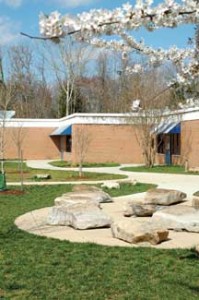 The entrance to the outdoor classroom curves away from the main pathway out of the school building. Newly planted trees, when mature, will shelter the site.
The entrance to the outdoor classroom curves away from the main pathway out of the school building. Newly planted trees, when mature, will shelter the site.
The play area to the far south side of the yard borders on the newly installed kindergarten pod play yard. The play yard is surfaced by broad swaths of red and blue soft-surface material, like that used under the playground equipment, and features a set of low curving concrete steps where the classes can sit or play during outdoor projects. Three blue and red metal tables have been added to the area, a popular place for outdoor snacks, and neighborhood residents watching their children on the play equipment during the afternoons and weekends.
Looking back on the process, David Judd and his team members at STUDIO39 feel the project was a rousing success, both in its execution and its use today. A common consensus is that much of the success was due to the school, community, and civic support and involvement. From the first stages of the design, Alexandria City, parents, teachers, and corporations willingly donated both time and money. Minor setbacks were easily solved with the help of this widespread group. The design process progressed easily because the participants were unified by common goals.
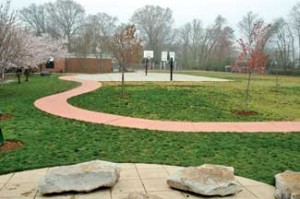 A new concrete basketball court is connected to the rest of the site by the red colored concrete walking trail. Two basketball nets, one adult sized and one child sized allow both younger and older players to take advantage of the court.
A new concrete basketball court is connected to the rest of the site by the red colored concrete walking trail. Two basketball nets, one adult sized and one child sized allow both younger and older players to take advantage of the court.
Today, the newly designed outdoor spaces and pathways are highly used and the landscape is finally cohesive, something that was lacking in the space before the redesign. The outdoor classroom has been popular both with the teachers and the students. The art teacher now holds nature drawing classes on the rock boulder, and at a recent meeting the principal remarked that she had even held a job interview out on the boulders on a sunny day. The teachers are big fans of newly installed benches which line the walking track and allow them to sit and still keep a close eye on their charges, while the students seem to be partial to the new track and playground equipment.
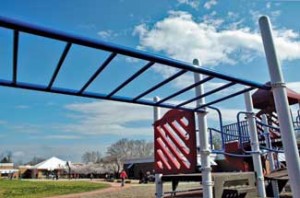 The concrete walking trail connects play areas with the rest of the site. Views from the play equipment include the basketball court, outdoor classroom and field.
The concrete walking trail connects play areas with the rest of the site. Views from the play equipment include the basketball court, outdoor classroom and field.
A dedication ceremony was held for the project on June 1, 2007. Attendees at the ceremony included the Mayor of Alexandria, and the entire construction team made up of individuals from STUDIO39, the Luck Stone Corporation, Simpson Burke Construction and Landscape Development Company. Key players and donors were presented with student designed posters at the ceremony. When the ribbon was finally cut, the students gave a resounding cheer. When asked if they would go through the process again, Thompson, McClary and Judd responded in unison “Absolutely!”
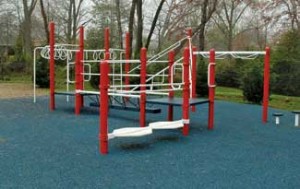 Students helped select the individual pieces of the new playground equipment. A school poll asked students to vote for their favorite elements.
Students helped select the individual pieces of the new playground equipment. A school poll asked students to vote for their favorite elements.
As published by Landscape Specifier Magazine
